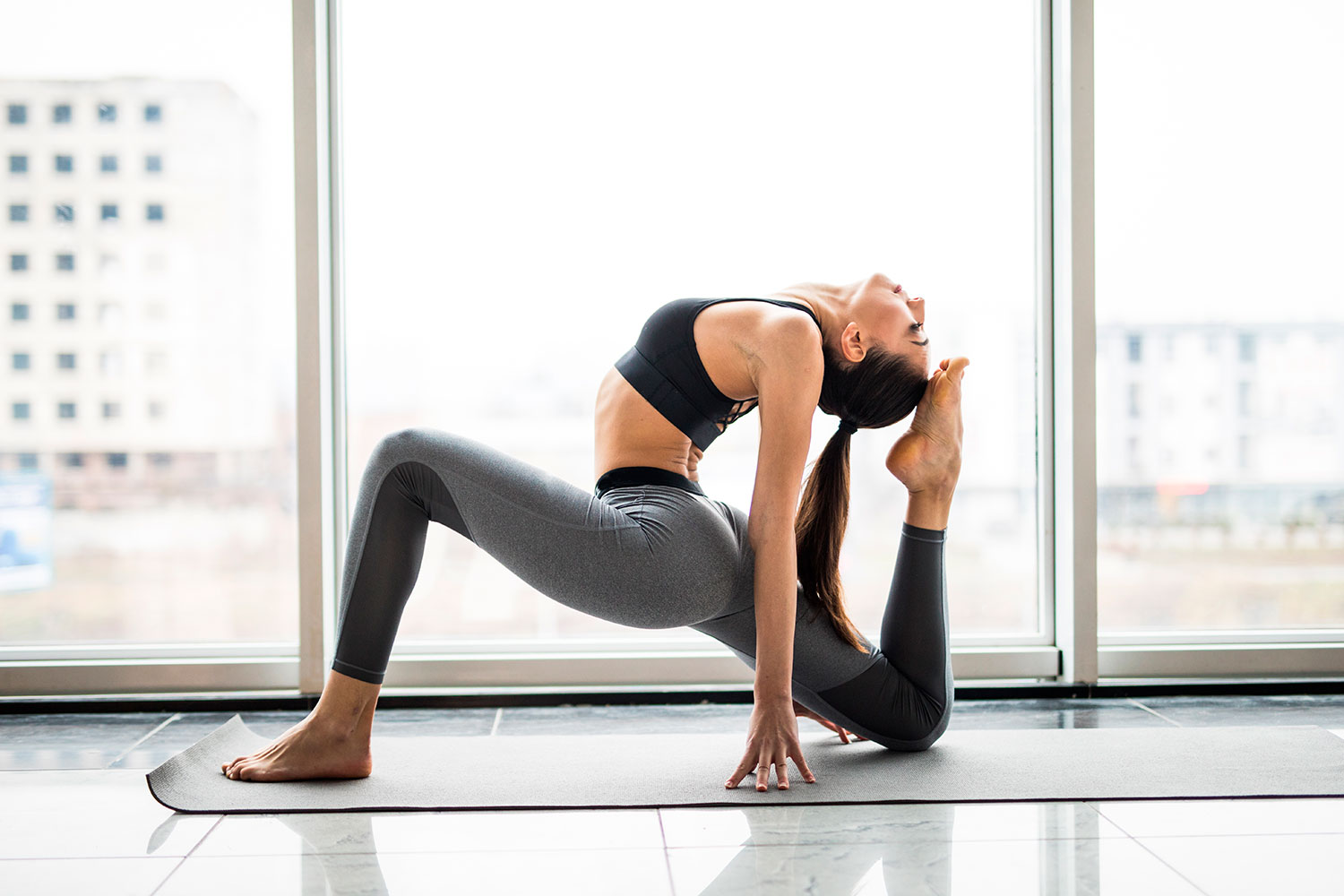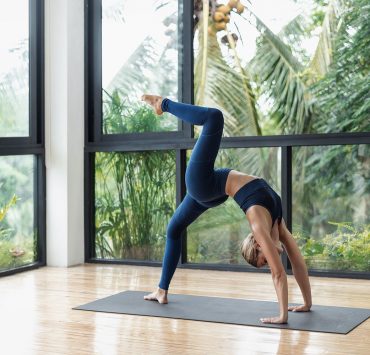
Having been a teacher’s assistant at over 50 yoga teacher…
According to Spine-Health.com, “sciatica describes the symptoms of leg pain—and possibly tingling, numbness, or weakness—that originate in the lower back and travel through the buttock and down the large sciatic nerve in the back of each leg.” Sciatica pain can be constant or happen just once in awhile, but when it is felt, you are likely to try anything to get it to stop. Thankfully, yoga is a wonderful exercise for sciatica.
Anatomy of the Sciatic Nerve

The sciatic nerve is the longest nerve in the human body! The nerve starts at lumbar segment 3 (L3), which is basically your lower back. Basically everything below this spot is connected to your sciatic nerve, which is why sciatic nerve pain really affects your buttocks, legs, and sometimes your feet. This nerves job is to send signals to and from the muscles in your lower body.
According to Yogi Approved, there are two primary causes of sciatica. The first is issues with the lumbar spine. This lower back area connects the thoracic (middle to upper back) to the tailbone. If your sciatica begins at the lower back and goes down, it’s a good idea to address the sciatica using the lower back as your starting point. The other root cause of sciatica is the piriformis muscle. This muscle is deep within the buttocks, and attaches the sacrum to the top of the femur. If your sciatica is focused in your buttocks, it can come from piriformis syndrome.
High Lunge

High Lunge is an awesome pose for sciatica. To get into the pose, follow these steps:
— Start in standing forward bend
— With an inhale, step one foot back to the edge of the mat.
— Form a right angle with the front knee. Make sure your knee isn’t falling to the inside of the body or spilling over the ankle.
— Lean your torso forward to lengthen the thigh muscles.
— Repeat to stretch he other side.
This pose might not be your automatic go-to for sciatica because it seems more strengthening than anything. However, high lunge can really open up your hips like no other pose. It also stretches your groin, legs, and arms. Yoga Journal even recognizes it as being a therapeutic pose for those with sciatica. If you want to hold the pose for longer, place a yoga block on either side of your foot and use it as a platform for your hands. This will offset your weight and allow you to stretch even deeper. Be careful though – holding poses too deeply for two long can actually cause sciatica in the long run. Just breathe, be gentle, and listen to your body. If it hurts, stop!
Reclining Hand to Big Toe Pose

This pose gives almost instant sciatica relief. To get into the pose, follow these instructions:
— Lay on the floor, placing a blanket under the head if needed.
— Keeping one leg on the ground, lift the opposite leg into the air.
— Keep both legs active and within the frame of the body.
— Grab the lifted leg with your hand and gently pull it towards you, keeping a slight bend in the knee.
— If you can’t reach your foot, use a yoga strap or towel.
— Repeat with the other leg.
Reclining hand to big toe pose can be done on the floor or in bed. This pose stretches your hamstrings deeply. According to this article, you can flex your foot towards your face to create a “flossing effect” for the sciatic nerve. This stretch will likely be really intense, but when you are done it will feel amazing. If you are super stiff, try practicing this pose with the resting leg’s heel pressed against a wall. The support will soften the groin muscles.
Restorative Bridge Pose

Unlike other back bending poses, restorative bridge will add to your energy and allow the muscles to passively relax. To get into the pose, follow these instructions:
— To practice this pose, you need a yoga block or bolster.
— Lay on your back, bend your knees, and put the prop under your sacrum.
— Once the prop feels comfortable, settle in and let your arms fall naturally by your side.
— Close your eyes and relax into the pose for a minimum of 5 minutes.
When done restoratively, bridge pose is relaxing and helps your body kick into the parasympathetic nervous system, which can accelerate healing. Physically the exercise strengthens the muscles that connect the butt to the legs and core, which will protect your nerves and keep them in alignment over time.
Reclining Hero’s Pose

While many of the pervious exercises focus on the back of the body, reclining hero’s pose puts a lot of emphasis on stretching the front of the thighs. To get into the pose, follow these instructions:
— Begin by gathering a yoga block, strap, and bolster.
— Prop the bolster up using the blocks.
— Neal with your body facing forward and your back to the bolster. Bring your knees together and slowly lie back on the bolster.
— To keep your legs in proper alignment, you can place a yoga strap around them.
— Once you are in the pose, relax and breathe for a minimum of ten minutes.
This pose is challenging but it will benefit your sciatica a lot. It mainly stretches the quadriceps and opens your hip flexors. Having tightness in those areas can contribute to sciatica and lower back pain in general.
Ardha Matsyendrasana (Seated Spinal Twist)

Twists are some of the best poses for your spine. That being said, sciatica can originate from the lumbar spine, so it’s beneficial to lubricate this area using twists. To get into the pose, follow these instructions:
— Sit on the floor with both legs stretched out.
— Bend one leg over the other and bring your heel to your buttocks.
— Bend the opposite leg towards the thigh.
— Cross the opposite-side hand over your knee, same-side hand goes behind your back.
— Concentrate the stretch on the back of the bend thigh and glutes. Be sure to switch after 5 breathes to get both sides.
Practicing this pose regularly can help your sciatica lessen. This pose is like getting a massage. It rings out your organs and muscles like a sponge, and floods them with new blood. This helps relieve pain and will give you a nice stretch in the legs at the same time.
Supine Figure Four

If you are experiencing intense sciatic pain, this pose will likely be pretty intuitive. To get into the pose, follow these instructions:
— Lay down on the mat with your knees bent.
— Cross one calf over your knee to make a square.
— Grab the back of the grounded leg and lift up.
— Gently pull the figure-four towards your chest, keeping your feet flexed.
— Gently release after 5-10 breaths and do the other side.
This pose opens up your lower back and the back of your legs simultaneously. It can also strengthen your core, which can help you prevent making any unnatural movements that might pinch the nerve or cause sciatica down the line. It will also help to put the spine back into proper alignment, which will help your sciatica over time.
Forward Fold Variation

Yogi Approved writer Allie Flavio explains this variation of forward fold in excellent detail. To get into the pose, follow these instructions:
— In Mountain Pose (Tadasana) cross your legs and bend your knees as much as you need to.
— Fold forward, letting your upper body relax.
— Point your hands to your toes and sway back and forth.
— Slowly raise up and cross your legs the other direction.
This pose strengthens and stretches the thighs and muscles around the lower spine. It’s also a great stretch for the hips, hamstrings, calves, and feet. Additionally, this pose is known for helping to calm the nervous system and relieve tension in the upper back and neck.
Pigeon Pose

If you look pigeon pose up in any yoga anatomy book, you will see why this pose is so beneficial for sciatica. Whether your pain is coming from the lower back or buttocks, this pose will hit the offending pinched nerve or tight muscle. To get into the pose, follow these instructions:
— Start in downward facing dog. Bring one leg forward and lay the outside of the leg on the mat while laying the back leg down.
— Depending on how flexible you are, your leg might be at an angle with your foot pointing out.
— Keep your back leg straight and within the frame of the body. Lower your torso down if possible.
This pose is known for stretching the buttocks, back of the thighs, top of the foot, and inner thigh. Practice on top of a folded blanket to make it a little less intense, or if your pelvic does not touch the floor. Over time, this pose will increase your range of motion in your hip flexor and femurs. It will also ease any lower back pain that comes from prolonged periods of sitting, walking, or standing. This pose is excellent to practice if your sciatica is triggered by long car rides, sitting at work, or running.
Downward Facing Dog

This is an excellent pose for sciatica because there are so many variations. To get into most common form of the pose, follow these instructions:
— Come to your hands and knees.
— Walk your hands forward, spread your palms, index fingers parallel or slightly turned out, and turn your toes under. Make sure your elbows are slightly bent and your arms are externally rotated.
— Exhale and lift your lower body up and back.
— Either keep your knees bent or if possible try to touch your feet flat on the ground.
— Keep your head active between your arms, don’t let it hang down all loose.
This pose stretches the backs of the thighs and brings space to the area around the lower back. You can deepen the pose by having a partner pull your hips up and back. You can also practice it with a yoga strap around a door jam. Another option, which is great for those with lower back problems, is to perform this stretch with your hands on a wall or countertop instead of on the ground.
Belly Down Savasana

While any type of relaxation will help you heal sciatic pain, you may want to try belly down savasana at the end of your yoga sequence. To get into the pose, follow these instructions:
— Place the bolster horizontal on your mat.
— Lay with your hips over the bolster.
— Stack your arms and rest your head on top.
This exercise comes from The Journey Junkie blog. According to the author, “The biggest benefit is that there’s no pressure on the nerve, creating freedom and space for this region of the body.” If your sciatica comes from your lower back, you can also relax the area by practicing savasana with your legs elevated on a chair.

What's Your Reaction?
Having been a teacher’s assistant at over 50 yoga teacher trainings worldwide, Rebecca Rebecca has a firm grasp on the fine art of yoga and meditation. In her work, she carefully reflects on a vast expanse of knowledge to help others find peace in both body and mind.














